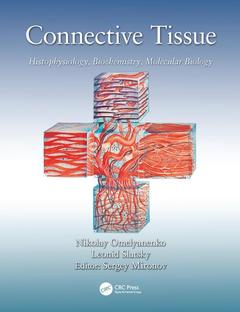Connective Tissue Histophysiology, Biochemistry, Molecular Biology
Auteurs : Omelyanenko Nikolay Petrovich, Slutsky Leonid Ilyich, Mironov Sergey Pavlovich

Connective tissue is a multicomponent, polyfunctional complex of cells and extracellular matrix that serves as a framework for all organs, combining to form a unified organism. It is a structure responsible for numerous vital functions such as tissue?organ integration, morphogenesis, homeostasis maintenance, biomechanical support, and more. The regeneration potential of connective tissue affects healing of damaged tissue and organs, while trauma, stress, and other factors that cause damage to connective tissue can lead to numerous disorders.
Connective Tissue: Histophysiology, Biochemistry, Molecular Biology brings together crucial knowledge of mammalian connective tissue (including human) and its components, both cellular and noncellular, in one authoritative reference. The breadth and depth of information has fundamental scientific significance as well as applied relevance in clinical medicine. The first half of the book covers the structure, classification, biochemical aspects, histogenesis, and cellular elements of connective tissue. It presents data from the macro- to nanolevel organization of the extracellular matrix?its structural and functional aspects?and addresses metabolic functions and the biochemistry and molecular biology of connective tissue ageing.
The second half of the book reviews current data on the biochemistry and molecular biology of skeletal connective tissue, including bone and cartilage metabolism and regulation. It presents an in-depth analysis of data on the molecular mechanisms of connective tissue ontogenesis, from embryonic development through ageing. It also reports novel findings on bone marrow stroma and describes electron microscopy results of the nanostructure of bone mineral, mineralized cartilage, and teeth compared with coral and seashells. Comprising both classic and modern data on the histopathology, biochemistry, and molecular biology of connective tissue, this book provides a unique resource for clinicians and researchers alike.
Peculiarities of Connective Tissue Histophysiology, Biochemistry, and Molecular Biology. Cellular Elements of Connective Tissue. Extracellular Matrix of Connective Tissue: Biochemistry and Histophysiology. Regulation of Connective Tissue Metabolic Functions. Biochemical and Molecular Biological Mechanisms and Manifestations of Connective Tissue Ageing. Bone – An Organ of the Support and Locomotor Apparatus Containing All Types of Connective Tissue. Cartilage – Cartilaginous Tissue: Structural, Biochemical and Molecular Biological Characteristics. Bone Tissue: The Structural-Functional, Biochemical and Molecular Biological Characteristics of Its Components. Biochemical Characteristics of Synovial Membrane and Synovia. Molecular Biological and Biochemical Regularities of Connective Tissue Structures Ontogenesis. References. List Abbreviations.
Nikolay Petrovich Omeliyanenko, Doctor of Medicine, Professor, Member of the New York Academy of Sciences, Winner of the Prize of the Russian Federation Government, the Chief of the Laboratory of Connective Tissue of the Central Research Institute of Traumatology and Orthopedics of N.N. Priorov, the Department of Public Health of the Russian Federation. The scientific interests: structural and functional organization of bone, cartilaginous tissue and other connective tissue types in health, regeneration and pathology.
Leonid Ilyich Slutsky,Professor Emeritus, Doctor Habilitatus of Medicine. In 1960–1996 – the Chief of the Laboratory of Biochemistry of the Riga Research Institute of Traumatology and Orthopedics (Latvia). The main scientific interests: biochemistry of the connective tissue and skeleton.
Sergey Pavlovich Mironov,Doctor of Medicine, Professor, Academician of the Russian Academy of Sciences and Russian Academy of Medical Sciences, Honoured Worker of Science of the Russian Federation, Winner of the State Prize and the Prize of the Russian Federation Government, the Head of the Central Research Institute of Traumatology and Orthopaedics of N.N. Priorov, the Department of Public Health of the Russian Federation. Field of research: clinical and fundamental orthopedics and traumatology.
Date de parution : 02-2017
21x28 cm
Date de parution : 12-2013
Ouvrage de 616 p.
21x28 cm
Thèmes de Connective Tissue :
Mots-clés :
Extracellular Matrix; Collagen Fibrils; Connective tissue; Articular Cartilages; Comp; Fibroblasts; Cartilage Oligomeric Matrix Protein; Multipotent stromal cell; Amino Acid Residues; Collagen fiber; Fibrous Framework; Proteoglycan; Connective Tissue Extracellular Matrix; Mesenchyme; Bone Tissue; BSP; Bone Sialoprotein; Growth Factor IGF-1; Focal Contacts; FC; Collagen Macromolecules; Endochondral Ossification; Large Proteoglycans; MSC; Cartilaginous Tissue; BMP; Growth Factor IGF1; CT; Lamellar Bone Tissue; Fibrillin Microfibrils; Cartilage Tissue



